Diagrams of Theory: Griswold's Cultural Diamond
Wendy Griswold is one of the central nodes in the boom of cultural analysis in sociology that started in the 1980s. The story goes: “culture” declined in favor among sociologists in the 1960s and 1970s, largely resulting from the backlash to Parsonian sociology – with his cultural systems of “ultimate values” downloaded into individuals’ personality systems such that they reproduce the social system (to really oversimplify).

The cultural diamond emerged out of Griswold’s dissertation research at Harvard, “Renaissance revivals: the continuing interaction between culture and society,” completed in 1980. Or, at least I assume, as I haven’t actually seen her dissertation. I also speculate that the diagram probably appeared in a paper, “The cultural diamond: alternative problems for research in the sociology of art” Griswold presented in 1981 at the Eastern Sociological Society’s meeting in New York. But, again, I haven’t actually seen this paper.
The first published iteration of the diagram is in Griswold’s first book Renaissance revivals: City comedy and revenge tragedy in the London theatre, 1576-1980, published in 1986.
A similar diamond model appears in Philip Ennis’ work. For example, in the Fall 1993 Newsletter of the ASA Sociology of Culture section, Ennis states (1993:15):
Each of the arts in any society has a determinable social structure consisting of four positions: the artist, the audience, the distributor, and the critic. ‘The Diamond’ as I call it, is the basic social molecule of all the arts.
The diamond shows up again in his 1992 book The Seventh Stream: The Emergence of Rocknroll in American Popular Music, but not as a figure (and no reference to Griswold’s work).
Roughly 25 years after Griswold coined the term, Gary Alan Fine referred to the cultural diamond as “Perhaps the central conceptual model within the sociology of culture approach” (2001:142). It is difficult to assess the extent this is the case. Searching Google Scholar with the phrase “cultural diamond” returns roughly 592 entries (as of August, 2023, including “Griswold” reduces this number to about 444).
In order to better understand what Griswold’s Cultural Diamond accomplishes, it is important to wrap our minds around the curious intellectual milieu in which Griswold first cut her teeth. In particular, there was (and I suppose continues to be) a distinction drawn between “culture” and “society” or, more narrowly “social structure.” This may seem, at first, like obvious – but I don’t really buy it. Rather than resulting from something about human life (i.e. that some real entity called “society” is completely different from some real entity called “culture”), this division is an artificat of disciplinary history in the United States. This is a two-pronged history.
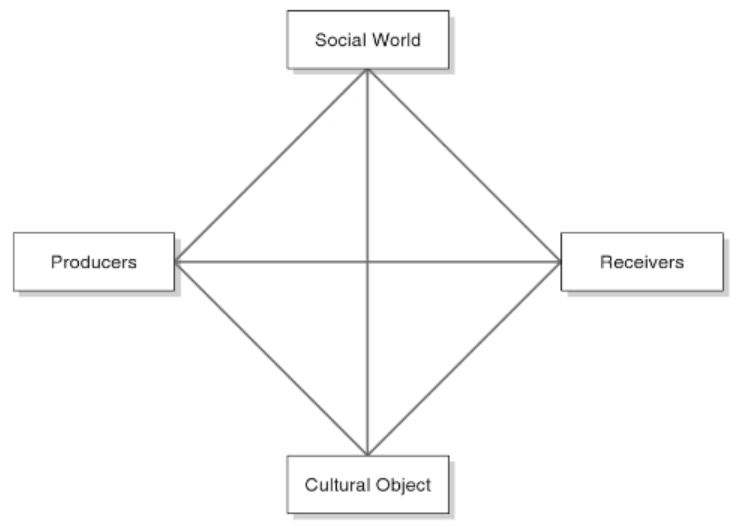
First, there is the Parsonsian formulation which divides the “social” system from the “cultural” system. Curiously, he made this division because he wanted all of the social sciences to have their own distinct “object” of study. Nice and tidy. Sociological myth refers to this as “Parsons’ Pact,” and I presume that the other disciplines that were privy to the pact probably don’t hear much about it. In short, Parsons tried to make clean categories out of messy life: to economics the economic system, to psychology the personality system, to anthropology the cultural system, and to sociology the social system. It might look good on paper, but reality pushes back. And, Parsons often violated his own scheme.
First, there was a quiet revolt against Parsons at Harvard starting in the mid 1960s. Mostly, masquerading as methodological innovation, the “structuralist” sociology led by Harrison White rejected the more “cultural” concepts of values and categories (which he felt were imposed by the analyst), and privileged “empirically” observable “social structures,” (which he presumed was more inductive).
Second, there is the (much less quiet) rise of Marxian sociology in the 60s and 70s, also (in part) a revolt against Parsons. Rather than omitting the “cultural” these researchers saw culture as a predominately a “reflection” or as “mirroring” of underlying class relations. Later iterations within this tradition offered much more sophisticated accounts of the relationship between the social structure and the “superstructure” (which is the term Marx used to refer to a grab bag of things, like morality, science, and law, and later interpreters consider equivalent to “culture”) (For example, in Peterson’s 1979 annual review, “Revitalizing the Culture Concept,” he outlines four approaches to this relationship.)
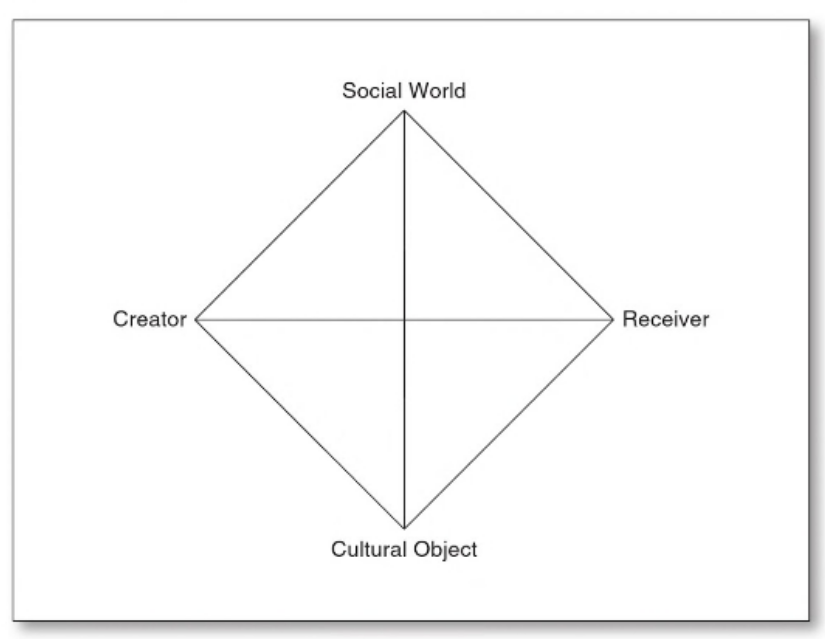
It is this latter school of Marxian-inspired work that results in the “production of culture” perspective (to which Griswold is an important contributor), predominately associated with the late Richard A. Peterson. His dissertation advisor at the University of Illinois was Alvin Gouldner, well-known for his critical approach to industrial and organizational sociology as well as his work on the production of ideas by intellectuals. Peterson merged Gouldner’s Marxian-critical approach to the study of industries to the production of cultural products, specifically (popular) music (see Creating Country Music: Fabricating Authenticity).
Given the division between “structure” and “culture,” that was emblematic of the 60s and 70s, Griswold’s Cultural Diamond calls attention to the “mutual constitution” between culture (i.e. cultural object, on the bottom) and society (i.e. the social world). This allows her to synthesize two general theories regarding the relationships between culture and society, “Mass Culture” and “Popular Culture” theories.
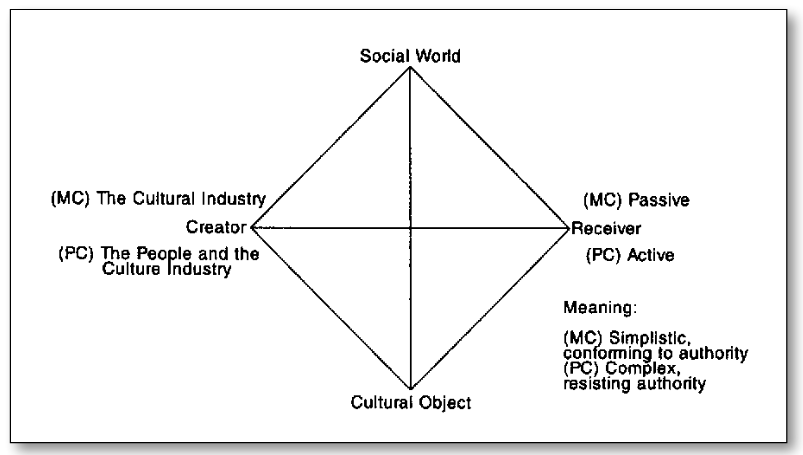
“Both the popular culture theorists like Fiske and the mass culture theorists like Wertham are essentially concerned with reception, and both share the value of human freedom, but they interpret the relationship between cultural object and receiver very differently… In the mass culture model, cultural objects impose their (simple, sensational) meanings on their audiences, but in the popular culture model, the audience makes new meanings.” (Griswold 2012:94)
Griswold’s work also brings in an additional dimension borrowed from the humanist disciplines (her bachelor and master’s degrees were both in English) as it relates to authors (i.e. creators) and readers (i.e. receivers or audiences).
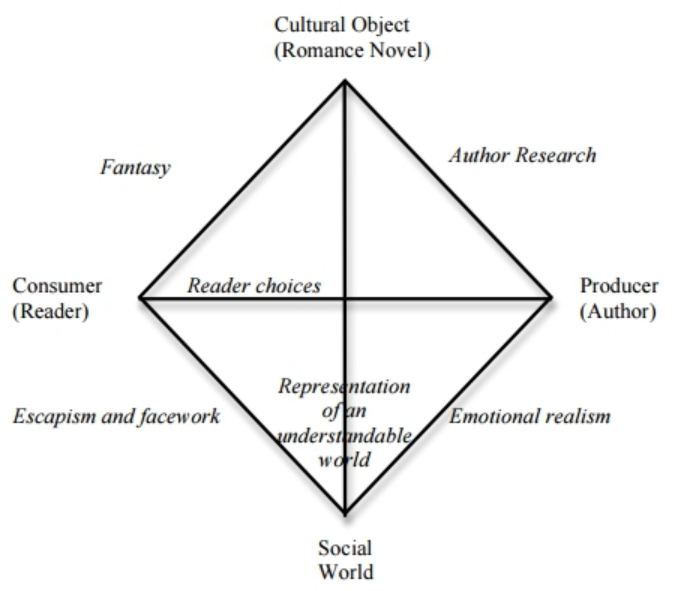
Furthermore, she argues that the each of the six links between each of the four points must be accounted for in order to adequately study culture. For example, see the above for a couple of Cultural Diamond’s which attempt to characterize the links between points with substantive content. In the left, the reader “chooses” an author, and has a “fantasy” with the romance novel.
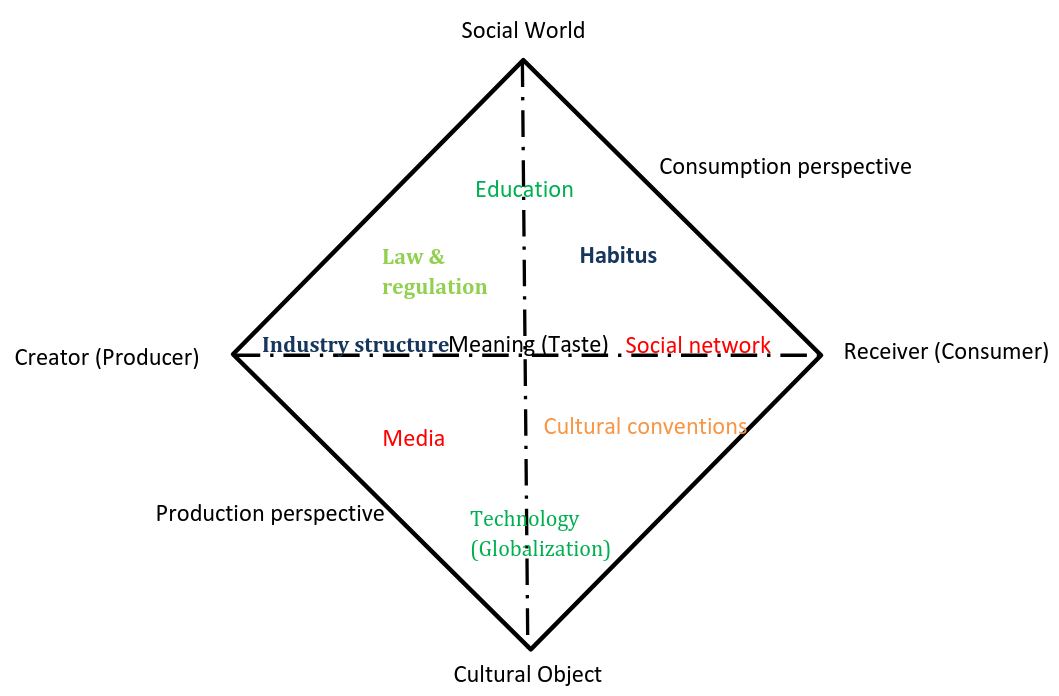
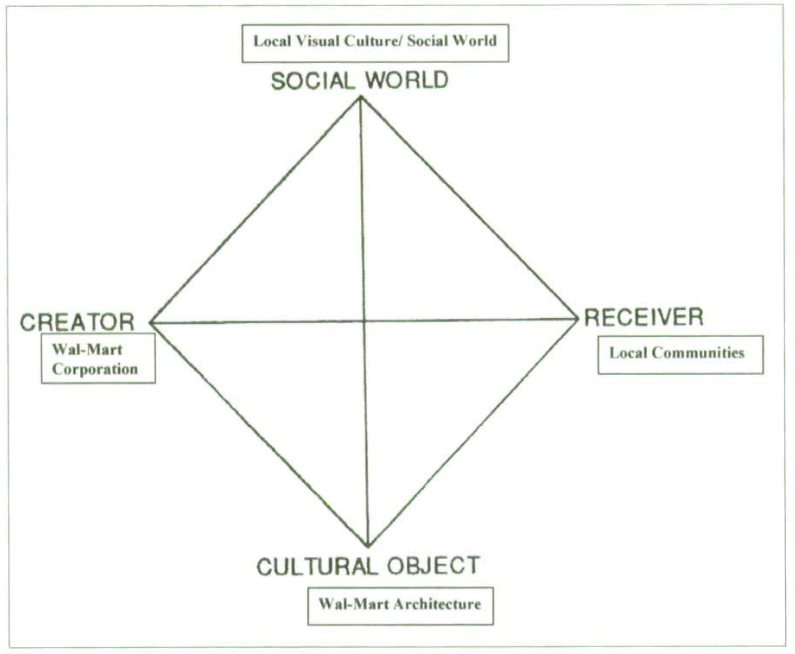
Within this framework or model, Griswold is able to direct the cultural analyst to (what she considers) all significant points in an analysis. If you agree, then a cultural study cannot simply assume that cultural objects “reflect” the social world without explicating how the “producers” of the cultural object organize and operate the production process and how the “receivers” of the cultural object interpret the final product. And how all this relates to the “social world.”
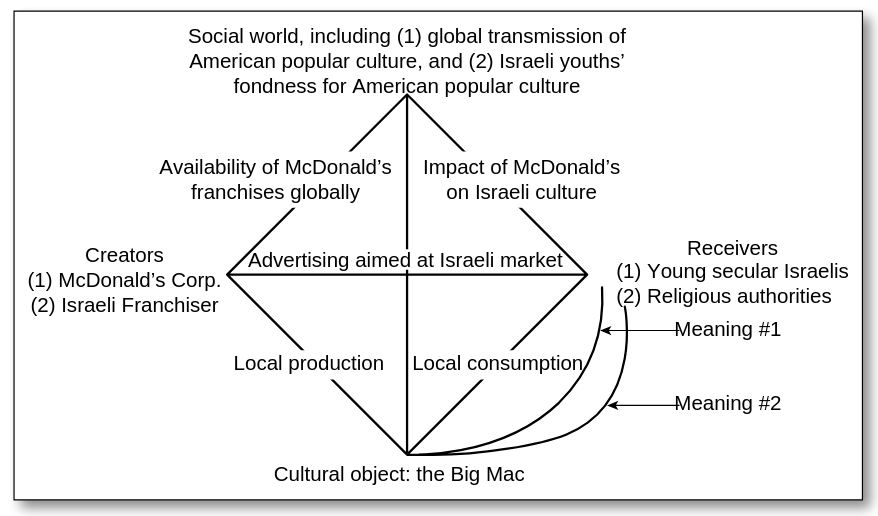
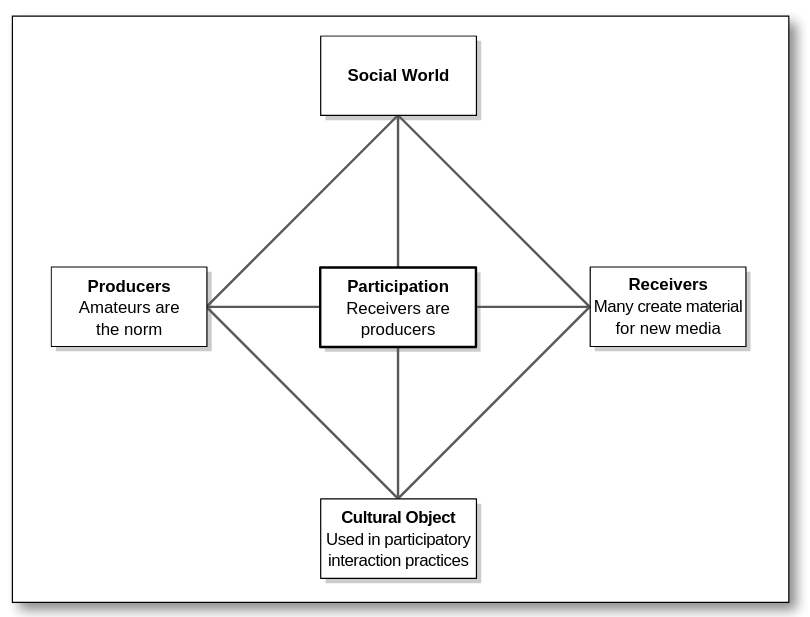
This also allows for a critique of Adorno and Horkheimer’s critical work “The Culture Industry: Enlightenment as Mass Deception,” a chapter in their 1944 book Dialectic of Enlightenment. They presume that the cultural receivers were fundamentally at the whim of cultural producers. This is sometimes referred to as the theory of “Mass Culture”.
But what about when the producers are the receivers? This is similar to what George Ritzer (author of McDonalization) refers to as “prosumption” or “prosumer capitalism.” In such a field, those who produce the cultural objects are also those who consumer, read, interpret, enjoy the cultural objects. However, as compared to other fields, such a form of social organization is not the norm.
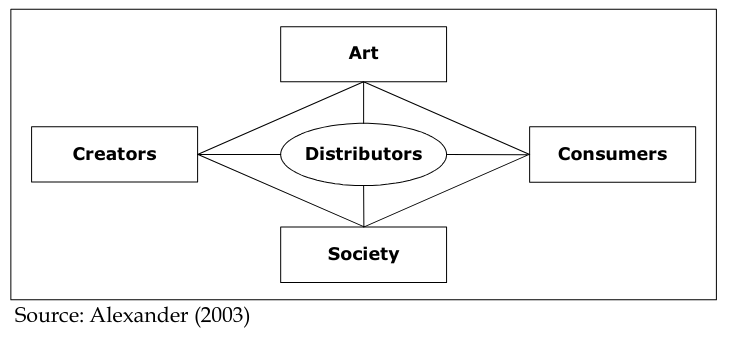
Rather the norm involves intermediaries between producers and consumers, which we might adequately refer to as distributors. See the above modification of Griswold’s Cultural Diamond. The addition is put forward by Victoria D. Alexander in Sociology of the Arts: Exploring Fine and Popular Forms. Here, rather than a merging of creators and consumers, as in the model of prosumption, Alexander wishes to call attention to the fact that artists may be more or less embedded in distribution systems. For example, a novelist is usually quite separated by distribution, while a screenwriter is likely to be much more involved, especially for television shows.
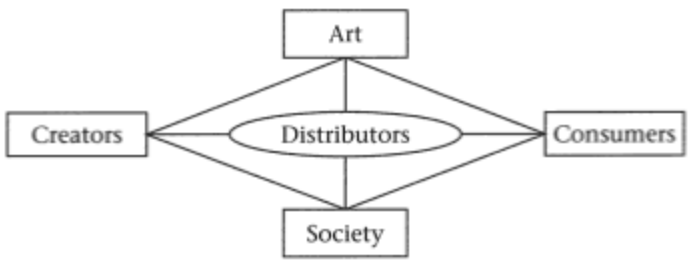
Some more elaborate modifications of Griswold’s Cultural Diamond exist. See below for a rendition in a working paper by Lettinga et al (2015:3) taken from Sabine De Lat’s Master’s Thesis [Dutch] in which they put forth the “Cultural Pyramid” which is based on Alexander’s addition of distributors to Griswold’s Cultural Diamond.
It is unclear exactly what the Pyramid is providing analytically that is not also provided by the original Diamond, and the authors are not explicit in highlighting its merits, so I will speculate. First, I presume that “public” is equivalent to consumers/receivers in previous models. Second, they include a space for “distribution” just as in Alexander’s modified cultural diamond.
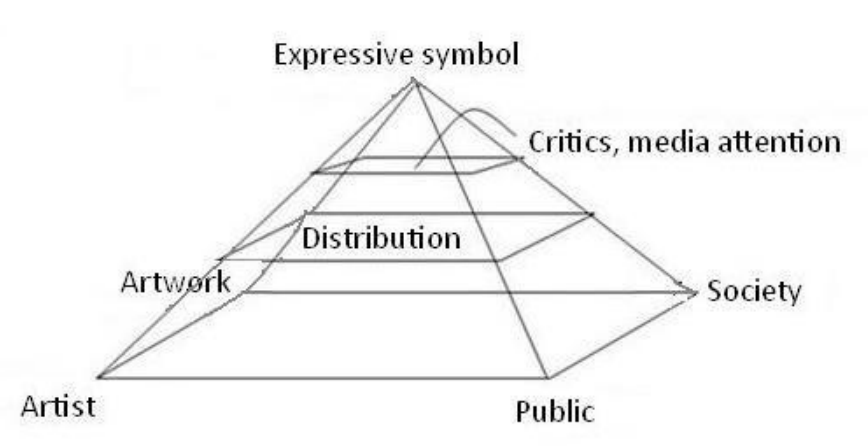
The first difference is the “expressive symbol.” We might presume that the expressive symbol is equivalent to the “cultural object,” however they also include a space for “artwork,” and so we are left to speculate what the mean. They explicitly define an expressive symbol as “overall image of the artist,” and as they are attempting to apply the model to the study of “celebrity,” but this offers little clarity. They suggest that the expressive symbol “an interaction between what the artist wants to show to audiences, and how the media receives this…,” but this is hardly different from what Griswold means by cultural object. (Moreover, what is the difference between an “expressive” symbol, and any other symbol?) Finally, just as Alexander considers distributors as not adequately conflated with producers, consumers, or society, Lettinga et al. appear to see critics and media attention as inadequately included in either consumers or society (or even artists, themselves). In my opinion they complicate the model, but reduce the overall analytical power.
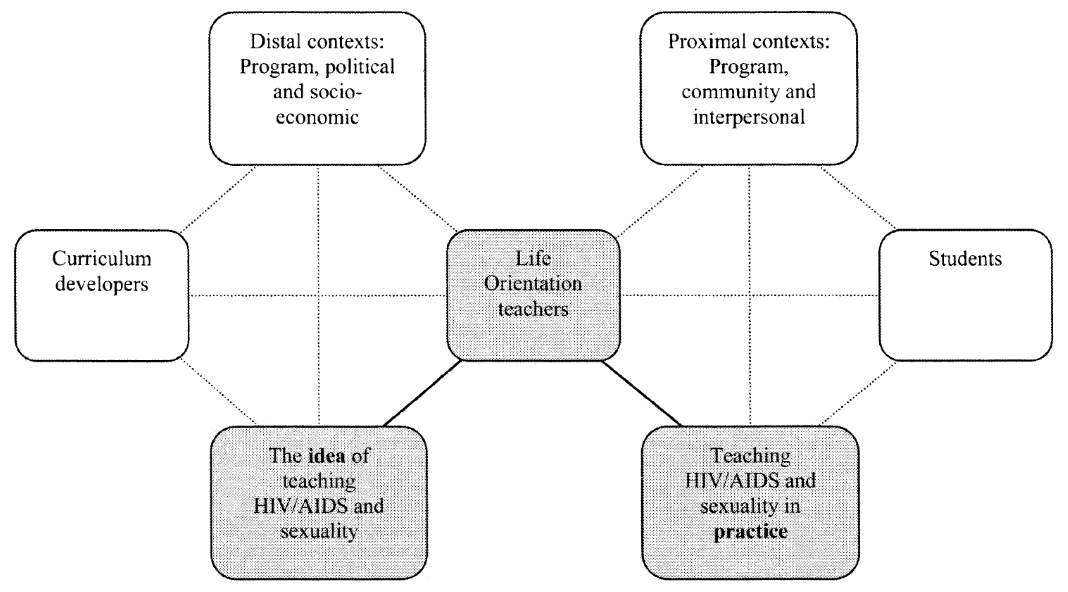
Another way in which the cultural diamond has been expanded is in the linking together diamonds as if belonging to “cycles” or “chains” of production and consumption. In Helleve et al. they demonstrate that there are, in a sense, multiple consumers in HIV/AIDS and sexuality teaching. For example, curriculum developers produce teaching materials, which are then “consumed” by teachers, who use these materials to produce the actual teaching in the classroom for students who are the end receivers. Although this “complicates” the Cultural Diamond, it feels like a much more useful elaboration, as compared to the Cultural Pyramid, because it immediately calls to mind network analysis, or even supply chain studies.
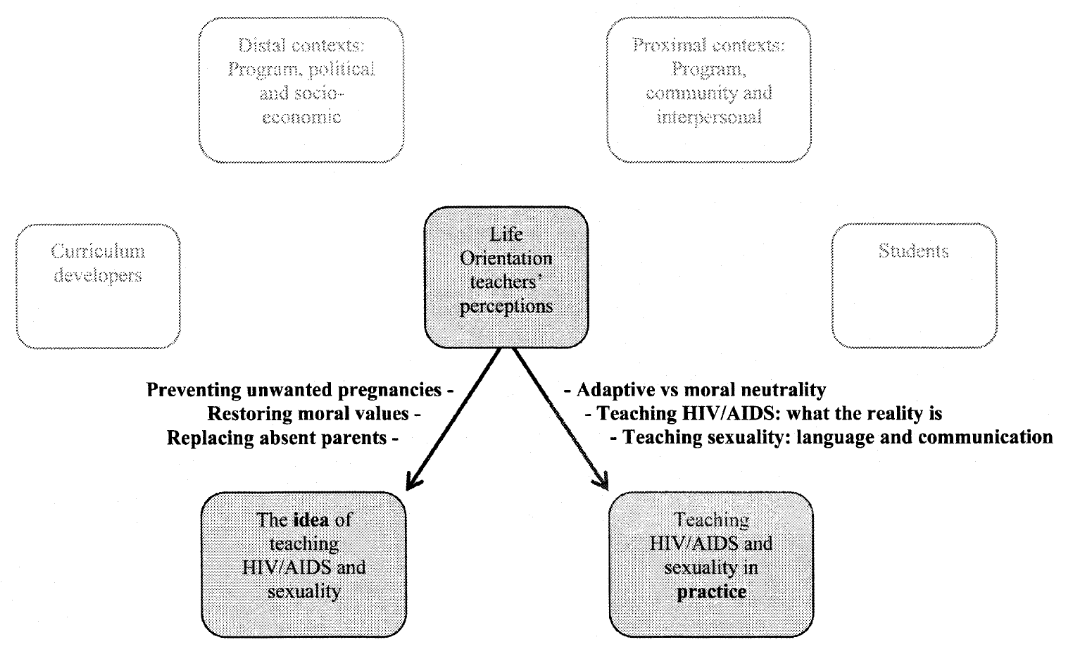
Ultimately, as I see it, diagrams are cognitive scaffolds. Either they convey an idea clearly, or they should be “good to think with” – i.e. productive. The Cultural Diamond has proved to be both.
References #
Adorno, T., and M. Horkheimer. 1994. “The Culture Industry: Enlightenment as Mass Deception.” Dialectic of Enlightenment 94–136.
Alexander, V. (1993). Sociology of the Arts: Exploring Fine and Popular Forms. John Wiley & Sons.
Barra, A. (2014). “Beyond the Bodice Ripper: Innovation and Change in the Romance Novel Industry.” Rutgers The State University of New Jersey.
Ennis, P. (1992). The seventh stream: The emergence of rocknroll in American popular music. Wesleyan University Press.
Ennis, P. (1993). “Back to Basics: The Diamond, The Stream, and the Parade.” Newsletter of the ASA Sociology of Culture section. Fall.
Fine, G. A. (2001). “Enacting norms: Mushrooming and the culture of expectations and explanations.” pp. 139-164 in Social norms. Russell Sage Foundation.
Griswold, W. (1986). Renaissance revivals: City comedy and revenge tragedy in the London Theater, 1576-1980. University of Chicago Press.
Griswold, W. (2012). Cultures and Societies in a Changing World. 4th Edition. SAGE.
Helleve, A., A. Flisher, H. Onya, W. Mukoma, and K. Klepp. (2009). “South African Teachers’ Reflections on the Impact of Culture on Their Teaching of Sexuality and HIV/AIDS.” Culture, Health & Sexuality 11(2):189–204.
Lettinga, A., S. Wagemakers, and J. Swanenberg. (2015). “Dutch Celebrities and Brabantish Identities.” Working Paper. Retrieved August 29, 2023
Newton, C. (2009). “The ‘sin’ of Wal-Mart Architecture: A Visual Theology Reflecting Economic Realities.” Implicit Religion. 12(1)
O’Reilly, D. (2005). “Cultural Brands/Branding Cultures.” Journal of Marketing Management 21(5-6):573–88.
Peterson, R. (2013). Creating Country Music: Fabricating Authenticity. University of Chicago Press.
Xu, Yifan. (2015). “Globalization of Millennial’s Music Consumption: A Cross-National Music Taste Study of Undergraduate Students in China and the U.S.” The Ohio State University.